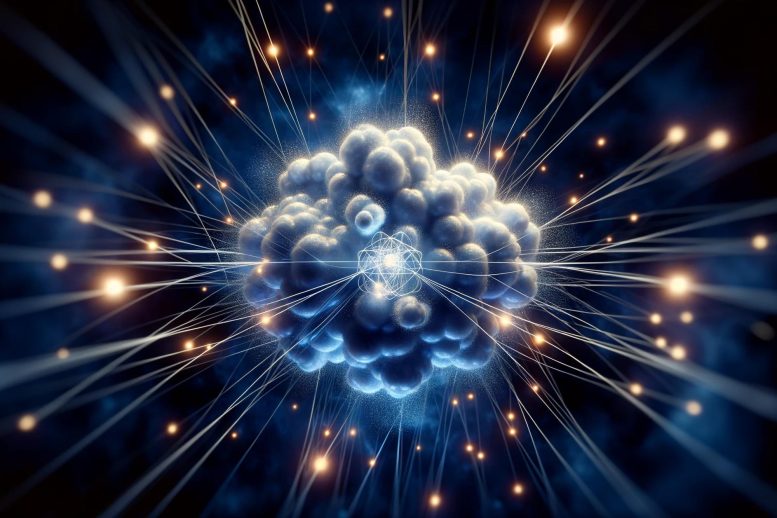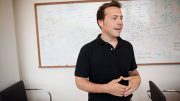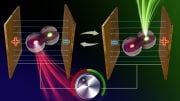
An international research team has made a pivotal discovery in high-temperature superconductivity by quantifying the pseudogap pairing in fermionic lithium atoms. This discovery not only deepens our understanding of quantum superfluidity but also holds promise for enhancing global energy efficiency through advancements in computing, storage, and sensor technologies. Credit: SciTechDaily.com
- Scientists have made a discovery that may help to unlock the microscopic mystery of high-temperature superconductivity
- The paper published in Nature could help address the world’s energy problems
- The new experimental observation quantifies the pseudogap pairing in a strongly attractive interacting cloud of fermionic lithium atoms
Breakthrough in High-Temperature Superconductivity
An international team of scientists has made a new discovery that may help to unlock the microscopic mystery of high-temperature superconductivity and address the world’s energy problems.
In a paper published in the journal Nature, Swinburne University of Technology’s Associate Professor Hui Hu collaborated with researchers at the University of Science and Technology of China (USTC) in a new experimental observation quantifying the pseudogap pairing in a strongly attractive interacting cloud of fermionic lithium atoms.
Quantum Superfluidity and Energy Efficiency
It confirms the many-particle paring of fermions before they reach a critical temperature and exhibit remarkable quantum superfluidity, instead of just two particles
High-temperature superconducting materials hold the prospect of significantly improving energy efficiency by providing faster computers, allowing novel memory-storage devices, and enabling ultra-sensitive sensors.
“Quantum superfluidity and superconductivity are the most intriguing phenomenon of quantum physics,” says, Associate Professor Hu, the only Australian researcher involved in the study.
Unveiling the Pseudogap Mystery
“Despite enormous efforts over the last four decades, the origin of high-temperature superconductivity, particularly the appearance of an energy gap in the normal state before superconducting, remains elusive.”
“The central aim of our work was to emulate a simple text-book model to examine one of the two main interpretations of pseudogap – the energy gap without superconducting – using a system of ultracold atoms,” explains Associate Professor Hu.
The investigation of pseudogap pairing with ultracold atoms was attempted in 2010 but was unsuccessful. This new international experiment used state-of-the-art methods for preparing homogeneous Fermi clouds and removing unwanted interatomic collisions, with ultra-stable magnetic field control at unprecedented levels.
“These new technical advances lead to the observation of a pseudogap. Without the need to invoke any specific microscopic theories to fit the experimental data, we found the suppression of spectral weight near the Fermi surface in the normal state.”
Associate Professor Hu is excited by his contributions to this landmark study.
“This discovery will undoubtedly have far-reaching implications for the future study of strongly interacting Fermi systems and could lead to potential applications in future quantum technologies.”
For more on this study, see Unlocking Quantum Superconductivity Mysteries With Ultracold Fermions.
Reference: “Observation and quantification of the pseudogap in unitary Fermi gases” by Xi Li, Shuai Wang, Xiang Luo, Yu-Yang Zhou, Ke Xie, Hong-Chi Shen, Yu-Zhao Nie, Qijin Chen, Hui Hu, Yu-Ao Chen, Xing-Can Yao and Jian-Wei Pan, 7 February 2024, Nature.
DOI: 10.1038/s41586-023-06964-y









Natural journal is a magazine that is neither honest nor scientific. They adhere to pseudoscientific ideas and refuse to discuss these topics. For example:They firmly believe that two objects (such as two sets of cobalt-60) of high-dimensional spacetime rotating in opposite directions can be transformed into two objects that mirror each other.
The branch of mathematics known as topology has become a cornerstone of modern physics. The perpetually swirling topological vortices defy traditional physics’ expectations. A physical properties of topological vortices is their to spontaneously begin to change periodically in time, even though the system does not experience corresponding periodic interference. Therefore, in the interaction of topological vortices, time is both absolute and relative,and physics often requires treating space and time at the same level.
Low-dimensional spacetime matter is the foundation of high-dimensional spacetime matter. Low-dimensional spacetime matter (such as topological vortex) can form new material structures and derive more complex physical properties via interactions and self-organization. It is extremely wrong and irresponsible to imagine low dimensional spacetime matter using high-dimensional spacetime matter.
Science must follow mathematical rules. For example, the Standard Model (SM) is considered to be one of the most significant achievements of physics in the 20th century. However, the magnetic moment of μ particle is larger than expected, revealed by a g-2 experiment at Fermilab, suggests that the established theory (such as SM) of fundamental particles is incomplete. Furthermore, the SM omitting gravity, it not involved the time problem and when the particle movement starts. Mathematics is the foundation of science. Physics must respect the scientific nature of mathematics and mathematical models. The SM must be based on mathematical models in order to be scientific, convincing, and in line with natural laws.
I hope researchers are not fooled by the pseudoscientific theories of the Physical Review Letters (PRL), and hope more people dare to stand up and fight against rampant pseudoscience.
The so-called academic journals (such as Physical Review Letters, Nature, Science, etc.) firmly believe that two high-dimensional spacetime objects (such as two sets of cobalt-60) rotating in opposite directions can be transformed into two objects that mirror each other, is a typical case of pseudoscience rampant.
If researchers are really interested in Science and Physics, you can browse https://zhuanlan.zhihu.com/p/643404671 and https://zhuanlan.zhihu.com/p/595280873.
The journal Nature is a magazine that is neither honest nor scientific, and tends to be more hypocritical.
Nature is outstanding journal.You guys doing cutting edge stuff can make mistakes. Nature depends on peer review which isn’t written in stone.
Very good! What is their peer review?
If you are interested, you can browse https://zhuanlan.zhihu.com/p/479457051.
Thank you very much for proposing the topic of peer review.
Today, we have already entered the era of the internet. With the help of artificial intelligence and big data, discussions on scientific knowledge have become open and transparent. However, a group of editors of so-called academic journals (such as Physical Review Letters, Nature, Science, etc.) are mystifying themselves. They only care about their own so-called sufficiently high priority rating, general significance, discipline, novelty, etc., and do not care about what science and pseudoscience are.
Science and pseudoscience are not determined by a publication, an organization or a person, nor by you or me, but by mathematics the final say. Physical models must be based on mathematics or mathematical models in order to be scientific, convincing, and in accordance with natural laws.
If you are interested, you can browse the comments in https://scitechdaily.com/microscope-spacecrafts-most-precise-test-of-key-component-of-the-theory-of-general-relativity/ and https://zhuanlan.zhihu.com/p/682393283.
Classical Mechanics. Predictions of the positions of particles is key to the forces unexplained. Gravity is a construct not a force. Space Time is a construct and not a force. knowing the position of any given known particle can provide the mathematical solutions to gravity and space Time. This should give solutions of motion of all matter and predictions of energy. Basically no motion no resistance to a higher state perceived energy. Wave Lengths are motion caused by radiation of light. I suggest finding the wholes and vortexes developed by mass in motion this this will be mathematical potential energy relative to other subatomic particles.
Scientific experiments are not omnipotent. We should act according to scientific laws. Any attempt to find categories of matter that go beyond mathematical definitions is unscientific.
Please answer:
1. Why do dark matter and dark energy use the word “dark”?
2. Is it appropriate to define “dark” if something that can be detected in scientific experiments?
3. Why can mathematics be called the language of science?
and so on.
Anybody who says that Physical Review Letters publishes pseudoscience, then goes on to mock the Standard Model, well, may suffer from a case of crackpottery, IMHO…
Physical Review Letters is the journal to which all other international scientific journals are judged. So venerated is it’s content that it’s meaningless to even question it, even if not questioning something is bad practice..
Go Physical Review Letters!
Go United States science!
Very good! The pride of Physical Review Letters (PRL).
However, this matter has nothing to do with United States science.
Please answer:
Can the Physical Review Letters (PRL) represent United States science?